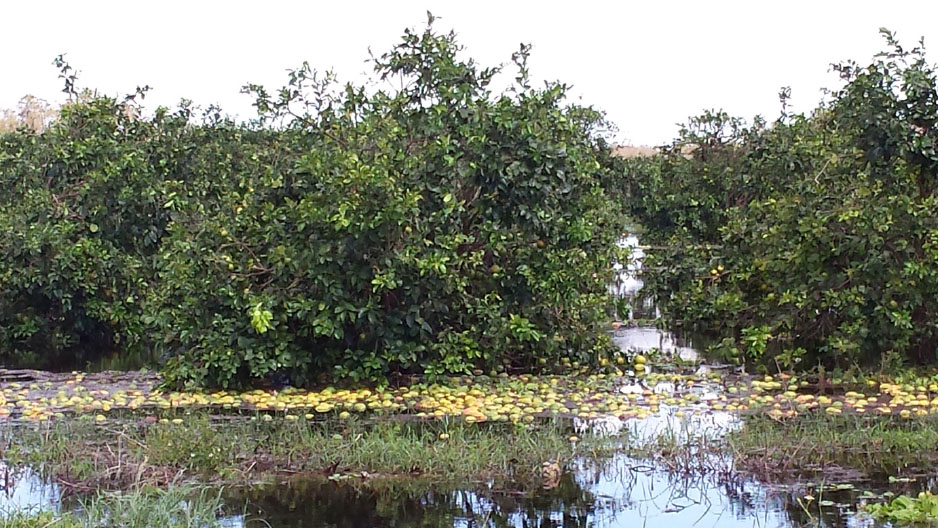
By Kristin Woods, Achyut Adhikari, Alex Castillo, Travis Chapin, Michelle Danyluk, Audrey Gamble and T. Matthew Taylor
Growers around the southern region are gearing up for a rainy fall. Preparing for and/or reacting to flooding is unfortunately part of the season. Knowing the food safety risks and regulations and having a proactive plan in place ahead of time can help reduce losses due to flooding.
Extension educators from Auburn University, University of Florida, Louisiana State University, and Texas A&M University have developed a free, comprehensive guide (Food Safety for Southern U.S. Food Crop Producers after Flooding available at www.aces.edu/go/1088) to help food producers better prepare and more readily recover from flooding events. The guide covers a broad range of considerations related to assessing risks from contaminated water and soil, as well as regulatory requirements and resources for recovery, some of which are summarized here.
CONTAMINATION CONCERNS
Floodwater is considered water that overflows from a pond, lake, river or other open water source. Floodwater may contain sewage, chemicals, heavy metals, pathogenic (disease-causing) microorganisms or other contaminants. Not all standing water in a field is considered floodwater. A problem with an irrigation system, which leads to excess standing water within the field, is not considered flooding. True flood events can pose a significant public health risk and impact soil fertility.
As floodwater contacts sources of contamination, such as human sewage, animal waste and industrial waste, it spreads these contaminants to other areas and water sources. Contaminants may also infiltrate through porous and permeable soils and reach groundwater. Floods can cause leakage of waste from underground septic tanks, resulting in effluent contamination in surface water. After flooding, the assessment of microbial and chemical quality of water is necessary before using the water for agricultural purposes. At a minimum, water sources should be tested for generic E. coli, an indicator of fecal contamination, after a flood. Depending on the circumstances, testing for pathogens or chemical contaminants may be wise.
NUTRIENT LOSS
In addition to the food safety considerations, flooding can result in loss of plant-available nutrients via soil erosion, leaching and losses of nitrogen through denitrification. Soil testing is recommended following flooding events to assess plant-available nutrient contents.
Flooding can reduce populations of soil microorganisms responsible for increasing the availability of phosphorus. After periods of prolonged flooding, phosphorus deficiencies can occur even if soil tests indicate adequate plant-available phosphorus concentration. Supplemental nitrogen applications may also be necessary to maintain production in cases where floodwaters have not contacted the harvestable portion of the crop and the grower wishes to salvage the crop.

The most straightforward flooding scenario for a grower to react to is when floodwaters directly touch the crop. In this case, all food crops the floodwater has touched, either in the field or stored in bulk, are considered adulterated under 02(a)(4) (21 U.S.C. 342(a)(4)) of the Federal Food, Drug, and Cosmetic Act and should not be used for human or animal food. This includes root crops grown in fields submerged by floodwaters.
If it is determined that the crop did not come in contact with the water or the wet soil, it may be harvested if it is possible to do so without contamination. However, it is important to consider all types of potential contaminants (chemical and microbial) linked to flooding.
ALTERNATIVE MARKETS
The U.S. Food and Drug Administration (FDA) is very clear that adulterated crops cannot enter human food channels. However, in the case of fresh fruits and vegetables, if they have not begun to spoil, they may be considered for diversion to animal feeds under certain circumstances. FDA and the state department of agriculture will work with growers on a case-by-case basis to recondition an adulterated crop into animal food.
Crops that are damaged by wind or hail, but not contaminated, could be diverted to a secondary market. Having a secondary market established ahead of time can save some time and money during an emergency.
RECOVERY RESOURCES
University Extension can help with assessing hazards and developing strategies for mitigating risk. The Southern Center for Training, Education, Extension, Outreach, and Technical Assistance to Enhance Produce Safety lists on its website (sc.ifas.ufl.edu) partners from land grant universities across the southern region who provide outreach to growers. Extension employees are many times among the first responders helping to assess damage and speed recovery in the agriculture community.
Local Emergency Management Agencies work with the U.S. Environmental Protection Agency and state environmental agencies to assess the release of hazardous substances into waterways. Each local agency keeps an inventory of hazardous substances (Tier 2 list) that can be helpful in determining if soil should be tested for deleterious substances after a flood.
The Food Safety for Southern U.S. Food Crop Producers after Flooding guide provides additional details to help growers assess the safety of a flooded crop, determine appropriate markets for damaged crops and find resources for recovery.
Kristin Woods is a regional Extension agent and Audrey Gamble is an assistant professor and Extension specialist, both with the Alabama Cooperative Extension System, Auburn University. Achyut Adhikari is an assistant professor and Extension food safety specialist for the Louisiana State University Ag Center. Alex Castillo and T. Matthew Taylor are associate professors at Texas A&M University.Travis Chapin is a state specialized Extension agent and Michelle Danyluk is a professor, both with the University of Florida Institute of Food and Agricultural Sciences.









